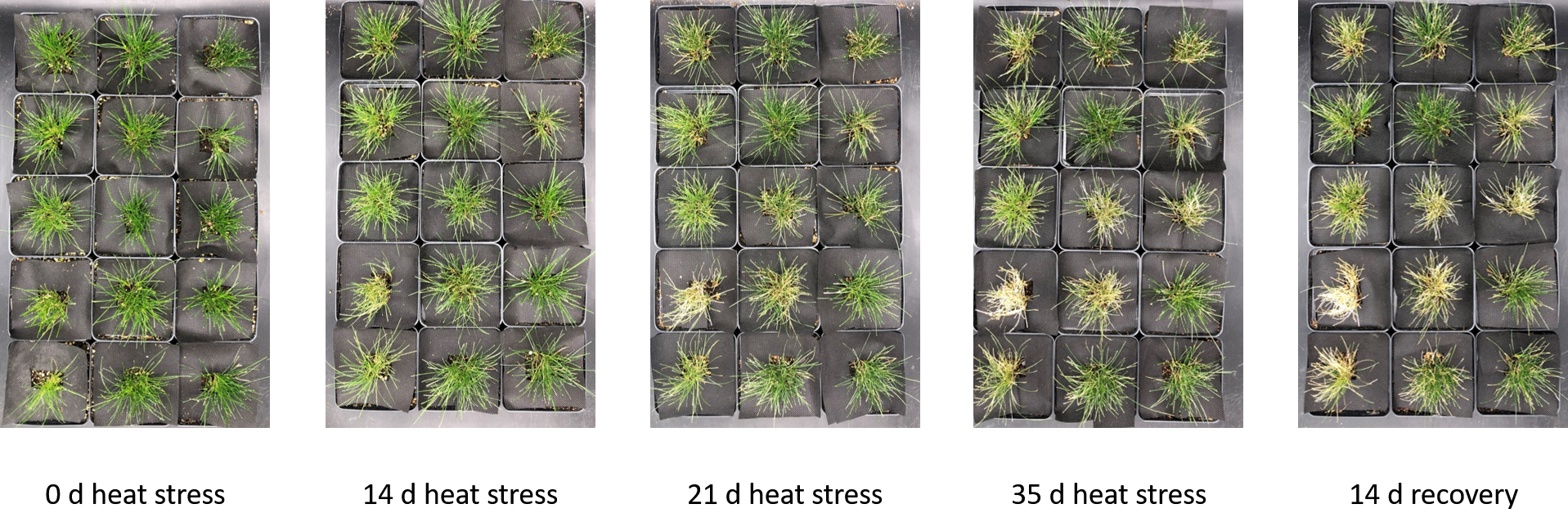By Cathryn Chapman and Bingru Huang, Rutgers University
Heat stress can limit the growth of cool-season turfgrass species and inhibit important metabolic processes and functions, which can negatively impact the overall aesthetic qualities of the turfgrass canopy. Damages to the turfgrass canopy due to heat stress can be severe and permanent if turfgrass plants experience prolonged temperature conditions that are above the optimal level. Increases in annual temperatures have created a demand for research that focuses on heat tolerant turfgrass species, particularly hard fescues, that can survive heat stress and recover from heat-induced damages. Thus, the objective of this study was to screen 240 genotypes of hard fescue plants for heat stress tolerance and post-heat stress recovery.
Hard fescue plants with unique and different genotypes were propagated from established stock plants and maintained in a greenhouse in individual pots for 7 weeks until plants were fully established. Plants were then transferred into a controlled-climate growth chamber for 3 d prior to initiation of heat stress treatment. After 3 days, the ambient temperature of the growth chamber was adjusted for heat stress treatment, which was 30/25 °C (day/night) for 35 d. After 35 d heat stress, all plants were exposed to ambient control temperatures of 22/17 °C (day/night) for 14 days to observe recovery from heat stress.
Throughout both the heat stress and post-heat stress recovery periods, plants were assessed for visual turf quality (TQ), dark green color index (DGCI), normalized difference vegetation index (NDVI), and % cover (as a measurement of canopy density). Photos were taken weekly under identical light conditions (Figure 1). The canopy temperature of each plant was also measured using a thermal infrared camera to determine the level of heat stress damage.
Based upon preliminary data, it is evident that certain genotypes had better performance levels in terms of these parameters. Each genotype can be placed into rankings of the highest, lowest, and middle-performing plants throughout the 35 d of heat stress and during 14 d of post-heat stress recovery. It is important to note that the highest rankings were based upon data which showed healthy plants and consisted of TQ ratings of 7 to 9 for more than half of the experiment, while middle rankings consisted of plants with TQ ratings of 4 to 6, and the lowest rankings consisted of plants with TQ ratings of 1 to 3. There was a total of 57 plant genotypes within the highest performing rank, 110 plant genotypes in the middle, and 73 plant genotypes that performed in the lowest ranking out of all 240 genotypes. Within this low ranking, there were 60 plants that included TQ ratings of 1 by the end of heat stress (representing completely dead plants with no green tissue). The TQ rating of 1 become evident for some of these plants as early as day 18 of heat stress. To compare, plants that were included in the highest and middle ranking still had TQ ratings that ranged between 6 to 9 at this same time period of 18 d heat stress. Most plants within both the highest and middle performing rank showed signs of recovery when the heat stress was alleviated after 35 days, with plants that were in the highest rank recovering more rapidly and to a greater extent than that of the plants that comprised the middle rank. Most plants in the lowest rank did not recover. The variations in heat tolerance of each genotype observed within this study can help improve breeding applications for hard fescue plant species, which is of great importance for areas with prolonged heat stress. Future work is still needed, however, to determine molecular and genetic differences between the heat tolerant and heat sensitive genotypes.
